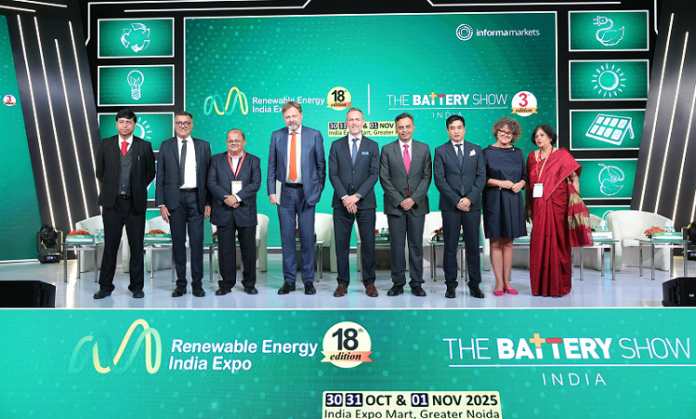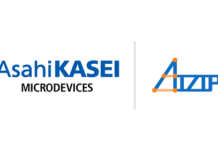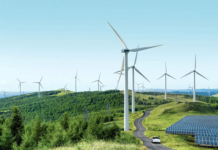
Highlights:
- Over 1,000 Exhibitors, 1,400 Brands, and 55,000+ Professionals Converge at the largest REI and TBSI 2025 edition
- India Crossed 250 GW Renewable Capacity in 2025, Targeting 500 GW by 2030
- Solis Unveils 125 kW Hybrid Inverter with 4-in-1 Smart Functionality for C&I Applications
- Replus Launches 5 GW Energy Storage System to Boost India’s Battery Manufacturing Capacity
- LONGi and Inox Enter Strategic Module Supply Agreement for Indian Market
Marking a significant milestone in India’s renewable energy journey, Informa Markets in India commenced the 18th edition of Renewable Energy India (REI) Expo at India Expo Mart, Greater Noida. Co-located with the 3rd edition of The Battery Show India (TBSI), the three-day event, running from October 30 to November 1, 2025, aims to strengthen global collaboration, innovation, and investment in advancing India’s clean energy ecosystem. Together, REI and TBSI represent the most influential gathering in South Asia’s clean energy landscape, uniting global manufacturers, innovators, investors, and policymakers under the unified theme “Decoding Pathways to Achieve Net Zero.”
Leaders and Global Dignitaries Grace the Inauguration Ceremony
The inauguration of India’s iconic show on innovative renewable energy and battery solutions was graced in the presence of key dignitaries such as Dr. Vibha Dhawan, Director General, TERI; Mr. Debashish Das, Head RE Nodal Agency, Govt. of Odisha; H.R.H Prince of Cambodia Narithipong Norodom, Business Expert & Advisor, CBC Chair for Cambodia; Dr. Ewa Suwara, Deputy Head of Delegation, European Union to India; Dr. Philipp Ackermann, Ambassador of Germany to India; Shri. Manu Srivastava, Additional Chief Secretary, Power and Renewable Energy Department, Government of Madhya Pradesh; Mr. Peter Hall, President, IMEA Region, Informa Markets, Mr Yogesh Mudras, Managing Director, Informa Markets in India, and Mr Rajneesh Khattar, Senior Group Director, Informa Markets in India.
Shri Manu Shrivastava, IAS, Additional Chief Secretary, Govt. of Madhya Pradesh, New & Renewable Energy department, said “India’s renewable energy sector today stands at the intersection of innovation, economic viability, and environmental stewardship. Having pioneered sub-₹3 per unit tariffs without subsidies and powered nearly 65% of Delhi Metro’s daytime demand, we have now reached another historic milestone delivering round-the-clock solar-plus-storage power at ₹2.70 per unit (around 3 US cents). Supported by global partners including the World Bank, IFC, ADB, and UC Berkeley, this achievement underscores how transparent bidding, effective risk mitigation, and investor confidence can create world-class benchmarks. The recently floated 440 MW solar-plus-storage project in Morena, Madhya Pradesh, with 95% availability for four peak hours through BESS, has established in India that solar energy remains viable even when stored and supplied during non-solar hours — a defining leap towards energy reliability and sustainability.”
Mr. Debashish Das, Head RE Nodal Agency, Govt. of Odisha, said “Odisha stands at a pivotal juncture in its energy transition a mineral-rich state that contributes nearly 25% of India’s coal reserves and produces close to 40% of the nation’s steel, along with substantial aluminium and cement output. Yet, as the second-largest greenhouse gas emitter, the state recognizes the urgency of shifting toward cleaner energy. Under the Odisha Renewable Energy Policy aligned with Viksit Odisha 2026 and Viksit Bharat 2047, we are prioritizing renewable adoption through initiatives like floating solar projects across our 2.25 lakh sq. km of water reservoirs and pump storage opportunities. These efforts not only safeguard fertile land but also open doors for international collaboration in clean energy. Our vision is to make energy in Odisha affordable, accessible, and sustainable transforming it into a tool of economic empowerment and positioning the state as a preferred investment destination in India’s renewable landscape.”
Dr. Vibha Dhawan, Director General, The Energy and Resources Institute (TERI), said ” India has already achieved 127 GW of installed solar capacity and is progressing steadily toward the 500 GW non-fossil energy target by 2030, a milestone that highlights India’s leadership in clean energy transition. With initiatives such as the National Green Hydrogen Mission, the Production-Linked Incentive scheme for solar and battery manufacturing, and the National Manufacturing Mission, the government is fostering a strong domestic value chain. At TERI, decades of research, capacity building, and partnerships have been directed toward unlocking India’s estimated 10,800 GW solar potential and advancing agri-photovoltaic models that drive rural growth. The focus now must shift toward viewing sustainability as a strategic enabler of industrial competitiveness and inclusive development.”
Dr. Philipp Ackermann, Ambassador of Germany to India, said “It is heartening to witness such a strong European participation at this year’s Renewable Energy India Expo, with 46 companies from Germany alone showcasing their commitment to India’s clean energy transformation. This growing collaboration reflects how the shift toward low-emission energy systems is not just an environmental imperative but also a powerful business opportunity. Under the Green and Sustainable Development Partnership signed in 2022 between our Prime Minister and the German Chancellor, Germany remains a steadfast partner in advancing renewable energy in India. Our private sector brings cutting-edge technologies and expertise in solar, wind, bioenergy, storage, and green hydrogen, while Indian enterprises contribute scale and dynamism. Together, through initiatives such as the newly established India-German Solar and Wind Energy Working Groups, we aim to build joint manufacturing capacities, mobilize green capital, and create a globally skilled workforce that drives sustainable growth and energy security.”
H.R.H Prince of Cambodia Narithipong Norodom, Business Expert & Advisor, CBC Chair for Cambodia, said “India has long been a valued diplomatic and cultural partner for Cambodia, and we now look forward to taking this relationship to the next level. As Cambodia aims to strengthen its independence and chart a sustainable future, India stands as the right partner to collaborate with in this journey. Renewable Energy India Expo offer valuable opportunities to exchange knowledge, build partnerships, and advance shared goals. Together, we believe that collaboration and mutual understanding will drive stronger progress for both nations.”
Dr. Ewa Suwara, Deputy Head of Delegation, European Union to India, said “According to a recent Asian Development Bank report, India could face a potential GDP loss of up to 24.7% by 2070 due to climate change, highlighting the need for immediate and collective action. In this context, green energy and clean industries are not merely options but imperatives for a sustainable future. The European Union deeply values its partnership with India, especially as both regions stand committed to advancing climate resilience, fostering innovation, and ensuring that ambition is matched by action. Together, through strategic collaboration and shared vision, we can bridge the gap between policy and progress.”
Sharing perspective on the co-located expos, Mr. Yogesh Mudras, Managing Director, Informa Markets in India, said, “India’s clean energy transition is accelerating faster than ever, with renewable capacity surpassing 250 GW in 2025 and a strong pipeline targeting 500 GW by 2030. The Ministry of Power has approved a ₹5,400 crore Viability Gap Funding (VGF) scheme for 30 GWh of Battery Energy Storage Systems (BESS), in addition to 13.2 GWh already underway, which is expected to attract ₹33,000 crore in investments by 2028. Platforms like Renewable Energy India Expo and The Battery Show India, celebrating its largest ever edition, are key to driving this evolution, serving as a confluence of innovation, policy insights, and cross-sectoral collaboration. With focused forums such as the CEO/CXO Conclave, CTO Forum, and Battery Tech Conference addressing the roadmap for advanced manufacturing, sustainable systems, and circular economy practices, this year’s edition stands as a powerful testament to India’s growing leadership in the global clean energy value chain.”
Unified Platform for Clean Energy Collaboration
The show floor at REI 2025 came alive with participation from over 700 exhibitors, 1,000 brands, and 250 global thought leaders, attracting more than 35,000 visitors over three days. Showcasing the entire spectrum of renewable technologies from solar manufacturing, battery storage, EV charging infrastructure, and inverters to biomass and wind energy, the event has set the stage for collaboration, innovation, and global partnerships. Running concurrently, The Battery Show India (TBSI) strengthens this narrative as South Asia’s leading platform for advanced battery manufacturing and energy storage technologies. Supported by the Department of Science & Technology and the Ministry of Heavy Industries, along with the Government of Odisha as State Partner, TBSI features 350+ exhibitors and 400+ brands, bringing together over 20,000 professionals across the global mobility and energy value chain, further reinforcing India’s emergence as a clean energy powerhouse.
Further amplifying the event’s international stature, country pavilions from Germany, Belgium, China, Japan, and Korea, supported by the European Union’s Cluster Collaboration Platform, highlight global participation. The Bio Energy Pavilion, supported by MNRE, showcases 65 global companies, emphasizing India’s growing role in diversified renewable technologies.
Prominent exhibitors include Reliance New Energy, INOX Solar, Adani Solar, Vikram Solar, Goldi Solar, Havells, Waaree Energies, Axitec Energy, FIMER, Gautam Solar, Ginlong (Solis) Technologies, Replus, Luminous Power, GREW Energy, and Dhash PV Technologies, among others. On the TBSI front, leading names such as Semco, Thermo Fisher, PNT Korea, Rubamin, Indygreen, Encore, Tex Technology, CBC Corporation, BASF, TVS Indeon, Nash Energy, and Ipower have showcased cutting-edge innovations across the energy storage spectrum.
Mr. Dhruv Dholakiya, Director, Goldi Solar, said, “India’s renewable energy landscape is at an inflection point, driven by innovation, scale, and self-reliance. At Goldi Solar, we are proud to contribute to this transformation as the country’s largest solar photovoltaic manufacturer, with 14.7 GW of module capacity and 17.2 GW of cell manufacturing in the pipeline. Our first 1.2 GW cell line will be operational by FY 26, followed by India’s largest single-location cell facility at Dahej, Surat, before FY 28. We are also expanding our global footprint with a new module manufacturing plant in the USA, producing modules made in America for America. At REI 2025, we are unveiling four cutting-edge, high-efficiency modules, including India’s first in-house Inter-Digitated Back Contact (IBC) concept module delivering up to 665 Wp at 23.08% efficiency, and a 715 Wp G12 module achieving 23.38% efficiency. With India’s renewable target of 500 GW by 2030, of which around 280 GW will come from solar, Goldi Solar remains steadfast in driving the nation’s clean-energy goals through technological excellence, backward integration and global agility.”
Ms. Shubhra Mohanka, Director, Gautam Solar Pvt Ltd, said “At REI, we are showcasing our new 640 W G12R series, one of the highest wattage solar modules in commercial production. It offers 5% higher output compared to a 590 W module while utilizing the same land area, ensuring optimal land use and lower BOS costs. India’s solar manufacturing capacity has grown exponentially from negligible levels just two years ago to nearly 120 GW today. With 28 years of expertise in the solar sector, Gautam Solar continues to inspire customer confidence through reliable products backed by 30-year warranties. We currently operate with 4 GW of ALMM-approved module capacity, another 1 GW under implementation and are setting up a solar cell manufacturing facility slated to begin operations in 2026, further strengthening our domestic value chain.”
Mr. Gyanesh Chaudhary, Chairman and Managing Director, Vikram Solar, said “The Renewable Energy India (REI) Expo 2025 continues to be a defining platform driving collaboration and innovation across India’s clean energy value chain. This year’s focus on solar energy, bioenergy, energy storage and emerging segments like e-mobility and green hydrogen underscores how integrated technologies are shaping the next decade of sustainable growth.At REI 2025, we are proud to unveil Hypersol Pro, our latest high-efficiency solar module that exemplifies our commitment to advancing technology and manufacturing excellence under the ‘Make in India’ initiative. With innovations like Hypersol Pro, we are setting new benchmarks in performance, reliability and smart design, developing future-ready solutions that strengthen India’s position as a global clean energy leader.”
Mr. Devesh Sharma, CEO of INOX Solar, said “India’s solar manufacturing sector is entering a transformative phase with policy alignment under ALMM, paving the way for deeper localization across the value chain. In this direction, INOX has partnered with LONGi to jointly supply 5 GW of high-efficiency modules over the next three years, combining LONGi’s R&D strength and INOX’s advanced manufacturing capabilities. Simultaneously, we are setting up a 10 GW solar cell plant and expanding our module production capacity by an additional 3 GW in Odisha, with operations expected to begin by Q2 2026. These developments not only position us to meet domestic demand under the ‘Make in India’ initiative but also to strengthen India’s global competitiveness in solar technology and exports.”
Mr. Bhupendra Singh Rawat, CEO, Dhash PV Technologies, said “India’s solar manufacturing ecosystem is witnessing remarkable growth, supported by strong policy measures like ALMM. DASH PV Technologies, India’s largest and the world’s leading non-Chinese integrated solar junction box manufacturer, currently operates at 40 GW capacity, expanding to 63 GW next month, and holds a 40% market share. Our new product line of interconnect busbars, launched at REI, will scale from 6.5 GW to 25 GW by March 2026, supported by a new 1,000 km/day solar DC cable line becoming operational in the next three months. complemented by a 1,000 km/day DC cable line coming online soon. The ALMM policy has propelled India’s solar module capacity to 116 GW and cell capacity to 42 GW by 2026, fostering self-reliance. With over 60 GW junction box and 43.5 GW busbar capacities established domestically, the focus now is on building an integrated ancillary ecosystem through initiatives like ALAM, ensuring India’s solar industry remains globally competitive.”
India Crossed 50% Non-Fossil Fuel Power Capacity
India has demonstrated remarkable strength in its power infrastructure, successfully surpassed 500 GW level with renewables having more than 50 per cent share, signalling another milestone in the nation’s clean-energy transformation. The country’s power capacity consists of 256.09GW from non fossil-fuel sources. A robust pipeline of wind, solar and storage projects in motion, India stands poised at the threshold of a deeper transition from capacity build-out to integration, storage and value-chain localisation.











